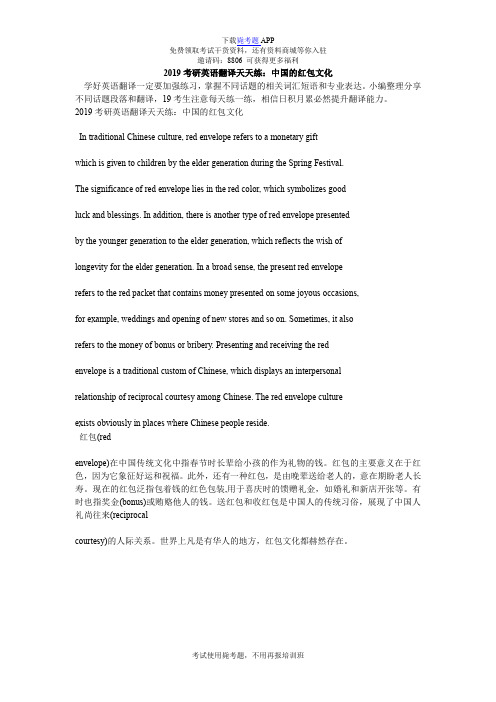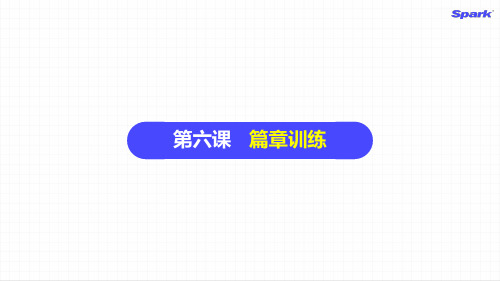中国文化翻译练习10篇
- 格式:doc
- 大小:56.50 KB
- 文档页数:16

2019年6月大学英语四级翻译练习题:剪纸2019年6月大学英语四级翻译练习题库英语四级翻译练习题:剪纸剪纸(paper cutting)有着悠久的历史,是传统的民间艺术形式。
它可以追溯到东汉时期。
在中国的传统文化中,剪纸可以反映生活的许多方面,如繁荣、健康或收获。
虽然其他艺术形式,如绘画,也可以显示类似的景象,但剪纸仍然以它的魅力脱颖而出。
今天,剪纸主要用做装饰。
中国人认为门上的红色剪纸可以给全家人带来好运和幸福。
剪纸在中国的传统节日,特别是春节(the Spring Festival)期间更常见。
参考翻译:Paper cutting is a traditional folk art form with along history.It can be dated back to the Eastern HanDynasty.In traditional Chinese culture, paper-cutscan reflect various aspects of life such asprosperity, health or harvest.Although other artforms, like painting, can also show similar scenes, paper-cuts still stand out for itscharm.Today, paper-cuts are chiefly used as decorations.Chinese people believe that the redpaper-cuts on the door can bring good luck and happiness to the whole family.The paper-cutsare more often seen during traditional Chinese festivals, particularly in the Spring Festival.1.剪纸有着悠久的历史,是传统的民间艺术形式:从整个句子来看该句有两个谓语动词,即“有着”和“是”,可将其中的“有着”翻译为with短语,即with a long history,"是”则用be 动词来表示。

剪纸(paper cutting)是中国最为流行的传统民间艺术形式之一。
中国剪纸有一千五百多年的历史,在明朝和清朝时期(the Ming and Qing Dynasties)特别流行。
人们常用剪纸美化居家环境。
特别是在春节和婚庆期间,剪纸被用来装饰门窗和房间,以增加喜庆的气氛。
剪纸最常用的颜色是红色,象征健康和兴旺。
中国剪纸在世界各地很受欢迎,经常被用作馈赠外国友人的礼物。
中国新年是中国最重要的传统节日,在中国也被称为春节。
新年的庆祝活动从除夕开始一直延续到元宵节(the Lantern Festival),即从农历(lunar calendar)最后一个月的最后一天至新年第一个月的第十五天。
各地欢度春节的习俗和传统有很大差异,但通常每个家庭都会在除夕夜团聚,一起吃年夜饭。
为驱厄运、迎好运,家家户户都会进行大扫除。
人们还会在门上粘贴红色的对联(couplets),对联的主题为健康、发财和好运。
其他的活动还有放鞭炮、发红包和探亲访友等。
以上这两段话想必大家非常熟悉,这两段分别是四六级样题给的新翻译题。
结合往年四六级翻译小题里面的考点和上面两道翻译样题,可以得出新翻译题的一些考点。
结合CET官方给出的评分细则,可以划分一下哪些地方是必须写对写好的,哪些地方是实在写不出也没很大影响的,也方便大家把握这最后三周的复习时间。
注:下划线处是已给出英文词汇的汉语。
红色是语法点,后面跟的括号为注释。
斜体是没有给出对应英文的翻译词汇,也就是需要通过背单词和积累才能轻松准确写出的词。
黄色底是翻译中重要的动词。
红色斜体是比较困难的需要积累翻译词汇才能写对的词汇,所幸四级翻译样题里没有。
剪纸(paper cutting)是中国最为流行的传统民间艺术形式之一(one of the most)。
中国剪纸有一千五百多年的历史,在明朝和清朝时期(the Ming and Qing Dynasties)特别流行(一般过去式)。

1. 刺绣(embroidery)是一种具有悠久传统的民间艺术,在中国艺术和手工艺品史上占有重要地位。
刺绣的长期发展离不开蚕的饲养与纺丝技术的发展。
中国是世界上第一个发现和使用丝绸的国家。
早在5000年前,中国就已经开始饲养蚕。
丝线和丝制品的生产促进了刺绣艺术的诞生。
时至今日,丝绣几乎传遍整个中国。
最好的绣品通常被认为来源于下面四省:江苏(尤其是苏州)、湖南、四川和广东,各省绣品各有特色。
Embroidery, a folk art with a long tradition, has an important position in the history of Chinese arts and crafts. During the course of its long development, embroidery has become inseparable from the raising of silkworms, silk reeling and weaving.China was the first country in the world where silk was woven. Silkworms were domesticated as early as some 5,000 years ago. The production of silk threads and fabrics gave rise to the art of embroidery. Today, silk embroidery is practiced nearly all over China. it is generally agreed that the best commercial products come for four provinces: Jiangsu(notably), Hunan, Sichuan and Guangdong , each with its distinctive features.2. 川剧(Sichuan Opera)就像四川火锅以及其他的名菜一样动人、丰富。

下载毙考题APP免费领取考试干货资料,还有资料商城等你入驻邀请码:8806 可获得更多福利2019考研英语翻译天天练:中国的红包文化学好英语翻译一定要加强练习,掌握不同话题的相关词汇短语和专业表达。
小编整理分享不同话题段落和翻译,19考生注意每天练一练,相信日积月累必然提升翻译能力。
2019考研英语翻译天天练:中国的红包文化In traditional Chinese culture, red envelope refers to a monetary giftwhich is given to children by the elder generation during the Spring Festival.The significance of red envelope lies in the red color, which symbolizes goodluck and blessings. In addition, there is another type of red envelope presentedby the younger generation to the elder generation, which reflects the wish oflongevity for the elder generation. In a broad sense, the present red enveloperefers to the red packet that contains money presented on some joyous occasions,for example, weddings and opening of new stores and so on. Sometimes, it alsorefers to the money of bonus or bribery. Presenting and receiving the redenvelope is a traditional custom of Chinese, which displays an interpersonalrelationship of reciprocal courtesy among Chinese. The red envelope cultureexists obviously in places where Chinese people reside.红包(redenvelope)在中国传统文化中指春节时长辈给小孩的作为礼物的钱。

第六课篇章训练篇章训练1-团圆饭春节前夕吃团圆饭是中国人的传统。
团圆饭是一年中最重要的晚餐,也是家庭团聚的最佳时机,家人生活在不同地方的家庭尤其如此。
团圆饭上的菜肴丰富多样,其中有些菜肴有特殊含义。
例如,鱼是不可缺少的一道菜,因为汉语中的“鱼”字和“余”字听上去一样。
在中国的许多地方,饺子也是一道重要的佳肴,因为饺子象征着财富和好运。
1.春节前夕吃团圆饭是中国人的传统。
词团圆饭a reunion dinner1.春节前夕吃团圆饭是中国人的传统。
词春节前夕the eve of the Spring Festival;the eve of the Chinese New Year1.春节前夕吃团圆饭是中国人的传统。
译文1Having a reunion dinner on the eve of the Spring Festival is a Chinese tradition.1.春节前夕吃团圆饭是中国人的传统。
译文2It is a Chinese tradition to have a reunion dinner on the eve of the Spring Festival.2.团圆饭是一年中最重要的晚餐,也是家庭团聚的最佳时机,家人生活在不同地方的家庭尤其如此。
译文Reunion dinner is the most important dinner of the year and the best moment/time for the family reunion,especially for families whose members live in different places.3.团圆饭上的菜肴丰富多样,其中有些菜肴有特殊含义。
译文1The dishes on the reunion dinner are various,and some of them have deep meanings.3.团圆饭上的菜肴丰富多样,其中有些菜肴有特殊含义。

中国结(Chinese knot)是中国文化的典型代表之一。
中国结源于古代,当时人们用系结的方式来记事,在唐宋时期(theTang and Song Dynasties)逐渐发展成为一种饰品,并在明清时期(the Ming and Qing Dynasties)开始盛行至今。
中国结象征着团结、友谊、和平、热情和爱情等。
制作中国结的材料多种多样,如棉线、丝编、尼龙(nylon)、皮革,甚至是一些贵重金属。
如今,中国结在世界各地广受欢迎。
Chinese knot is one of the typical symbols of Chinese culture.It appeared in ancient times when people tied knots to keep records.It developed gradually as a type of decoration during the Tang and Song Dynasties,and prevailed from the Ming and Qing Dynasties up to now.Chinese knot means reunion, friendship, peace, warmth, and love, etc.Materials used to make the knots are various, such as cotton, silk, nylon, leather andeven precious metals.Today, Chinese knot is popular in many parts of the world.聘金(endowment)是中国传统习俗的一部分。
通常,新郎(bridegroom)需要给新娘家一笔钱作为聃礼来定下婚礼。
但是近几年来其标准不断上升,致使大多数家庭都很难达到。
快速上涨的生活成本是聘金增加的主要原因。
1.长城常被看作是中国文化和历史的象征。
(2004年真题)。
The Great Wall is often regarded as the symbol of Chinese culture and history.2.只有在黄山,你才可以欣赏到如此的美景。
(2007年真题)。
Only on Mountain Huangshan can you see such beautiful scenery.3.我们在做出任何决定之前,应该听一听其他人的意见。
(2007年真题)We should consider the opinions of other people before we make any decision.4.我们不能简单地根据一个人受过多少教育来判断他的能力大小。
(2005年真题)。
We cannot judge a person’s ability simply on the basis of his education.5.一本好的英汉字典不是由其厚薄来评定的,而是由其质量来评定的。
(2007年真题)A good English-Chinese dictionary is judged not by its thickness but by its quality.6.我认为你还没有意识到读书的重要性。
(2008年真题)I don’t think you have realized the importance of reading.7.北京2008年奥运会将对中国的经济产生很大影响。
(2008年真题)The Beijing 2008 Olympic Games will exert/have great influe nce on China’s economy.8.他工作表现出色,最近被提升为部门经理。
(2008年真题)He has been promoted to the position of department manager for his excellent performance.9.我们看电视的目的是为了了解周围发生的事情。
在广袤无垠的中华大地上,有着无数绚丽多姿的自然景观,五千年的灿烂文化把这如诗如画的江山打扮得分外妖娆。
全国各地的名胜古迹都是游客向往的地方,如古城西安的兵马俑、首都北京的长城和故宫、南方桂林的山水。
今天我向各位介绍号称我国五岳之首的泰山,这五岳为东岳的泰山、南岳的衡山、西岳的华山、北岳的恒山和中岳的嵩山。
泰山地处我国山东省的中部,绵延200多公里,其巅峰位于泰安市北面,海拔1545米。
泰山雄伟壮观,峻拔突兀,最高峰玉皇顶为峡谷和险峰所环绕。
登临泰山需走九曲十八盘的路程,沿途可饱览绚丽的风光,欣赏不同风格的古代建筑。
一阶石梯,直通南天门。
登上日观峰,举目远眺,只见山外有山,竟外有景,无限风光,摄人心魄。
泰山将自然景观与文化景观完美地融为一体,山上有无以计数的奇石、清瀑、古松、石桥、庙宇、亭阁、古塔、殿堂。
名胜古迹数不胜数,尤其是历代文人雅士书法家所留下的石刻碑文,令游客目不暇接,叹为观止。
泰山的每个季节都有独特的魅力。
春天,绿茵茵的山坡上,争奇斗艳的花朵到处可见。
夏天,泰山的雷暴雨堪称奇观。
秋天,枫树叶漫山遍野,蔚蓝色的河水穿流而行。
冬天,雪盖群峰松披霜,景观素雅悲壮,别有一番情趣。
喜逢艳阳日,极目远眺,重峦叠嶂,尽收眼底。
但遇天阴时,环顾四周,苍茫大地,尽入云海。
泰山的日出与日落,闻名遐迩。
壮观的自然风景以及不可计数的历史古迹,激发了古代文人书法家,为之舞文弄墨,创作了无数佳作。
泰山历来是画家和诗人钟情的聚集地。
早在殷商时期,我们华夏祖先便已确立了东、南、西、北、中五个方位。
太阳初升的东方代表了冬去春来、万物繁衍昌盛的景象。
位于中国东部的泰山一直被视为吉祥之地。
古代帝王择泰山登临,供以祭品,祭祀天地,为国家的繁荣祥和而祈祷。
据历史记载,西周前已有72位君主登临泰山祭祀。
此后,中国历史上第一个皇帝秦始皇,以及汉、唐、宋、清等朝代的皇帝,都亲自登临泰山祭祀。
现代世界也认识到泰山的旅游价值和文化价值,早在1985年,联合国教科文组织世界遗产委员会便将泰山列入联合国“世界自然与文化双遗产名录”之中。
段落翻译一、对龙图腾的崇拜在中国大约已绵延了八千多年。
中国龙是古人将鱼、蛇、马、牛等动物与云雾、雷电等自然天象集合而成的一种神物。
中国龙的形成与中华民族的多元融合过程同步。
在中国人的心目中,龙具有振奋腾飞、开拓变化的寓意和团结凝聚的精神。
二、秧歌舞是中国汉族的一种民间传统舞蹈,通常在北方省份表演。
秧歌舞者通常穿上明亮多彩的表演服装,他们的表演动作有力迅速。
在农历春节、元宵节等节日期间,人们一旦听到锣鼓声,不管外面天气有多冷,他们都会蜂拥到街上看秧歌舞表演。
近年来,中国东北某些城市的老年人自发组织了了秧歌队,队员常年通过跳秧歌舞来保持健康,同事他们也乐在其中。
三、长城是人类创造的世界奇迹之一。
如果你到了中国却没去过长城,就想到了巴黎没有去看看菲尔铁塔,或者就像到了埃及没有去看金字塔一样。
人们常说:“不到长城非好汉。
”实际上,长城最初只是一些断断续续的城墙,直到秦朝统一中国后才将其连城长城。
然而,今天我们看到的长城——东起山海关,西至嘉峪关——大部分都是在明代修建的。
四、饺子是深受中国人民喜爱的传统食品。
相传为古代医圣张仲景发明。
饺子的制作是包括:1)擀皮、2)备馅、3)包馅水煮三个步骤。
其特点是皮薄馅嫩,味道鲜美,形状独特,百食不厌。
民间有“好吃不过饺子”的俗语。
中国人接亲待客、逢年过节都有包饺子吃的习俗,寓意吉利。
对崇尚亲情的中国人来说,“更岁交子”吃饺子,更是欢度除夕、辞旧迎新必不可少的内容。
五、针灸是中医学的重要组成部分。
按照中医的经络理论,针灸疗法主要是通过疏通经络、调和气血,来达到阴阳归于平衡,使脏腑趋于调和之目的。
其特点是“内病外治”。
主要疗法是用针刺入病人身体的一定穴位,或用艾火的温热刺激烧灼病人的穴位,以达到刺激经络。
治疗病痛的目的。
针灸以其独特的优势,流传至今并传播到了世界,与中餐、功夫、中药一起被海外誉为中国的“新四大国粹”。
六、中国功夫即中国武术,是将技击寓于搏斗和套路运动之中的中国传统体育项目,承载着丰富的中国民族传统文化。
1徐霞客一生周游考察了十六个省,足迹几乎遍及全国。
他在考察的过程中,从来不盲目迷信书本上的结论。
他发现前人研究地理的记载有许多很不可靠的地方。
为了进行真实细致的考察,他很少乘车坐船,几乎全靠双脚翻山越岭,长途跋涉;为了弄清大自然的真相,他总是挑选道路艰险的山区,人迹稀少的森林进行考察,发现了许多奇山秀景;他常常选择不同的时间和季节,多次重游各地名山,反复观察变换的奇景。
Xu Xiake toured and investigated 16 provinces in his lifetime, covering almost the whole of China/ the whole country. When he was carrying out his investigations, he never took blind belief in the conclusions in the books. Instead he found a lot of unreliable points in the geographic records taken by his predecessors. In order to make his investigations reliable and thorough, he seldom traveled by carriage or boat. Instead, he took long, arduous trips on foot almost all the time, climbing mountains and hills. In order to learn about the truth of nature, he always chose to conduct investigations in mountainous areas with dangerous roads and in lonely / untraveled woods, where he discovered a lot of magnificent peaks and beautiful sights.2多少年来,我养成了一个习惯:每天早晨四点在黎明以前起床工作。
. . 一、京剧被誉为“歌剧”, 是地道的中国国粹。它起源于中国多种古老的地方戏剧,特别是南方的“徽班”。到了 19 世纪末,京剧形成并成为中国最大的戏曲剧种。京剧是综合性表演艺术,集唱(歌唱)、念(念白)、做(表演)、 打(武)、舞(舞蹈)为一体,通过程式化的表演手段,叙述故事,刻画人物。 角色主要分生(男性)、旦(女性)、净(男性)、丑(男性女性皆有)四大行当。 (1) 京剧被誉为“歌剧”, 是地道的中国国粹。 Praised as “Oriental Opera”, Beijing Opera is a genuine national quintessence of China. (2) 它起源于中国多种古老的地方戏剧,特别是南方的“徽班”。 It originated from many kinds of ancient local operas, especially huiban in southern China. (3) 到了 19 世纪末,京剧形成并成为中国最大的戏曲剧种。 At the end of the 19th Century, Beijing Opera evolved and took shape, becoming the greatest kind of opera in China. (4) 京剧是综合性表演艺术,集唱(歌唱)、念(念白)、做(表演)、 打(武)、舞(舞蹈)为一体,通过程式. . 化的表演手段,叙述故事,刻画人物。 Beijing Opera is a blend of performing arts---song, speech, performance, acrobatic fighting and dance. Beijing Opera portrays and narrates the plot and characters through stylized acting. (5) 角色主要分生(男性)、旦(女性)、净(男性)、丑(男性女性皆有)四大行当。 The main types of roles in Beijing Opera are sheng (male), dan (young female), jing (painted face, male), and chou (clown, either male or female). 二、道教是中国土生土长的。创始人是春秋末期的哲学家、思想家老子。道教以老子所著的《道德经》为主要经典。道教主“重人贵生”, 崇尚清静无为,修身养性。“道可道,非常道。名可名,非常名。无名天地之始;有名万物之母。故常无,欲以观其妙;常有,欲以观其徼(jiao4)”便是老子的至理名言。 (1) 道教是中国土生土长的。创始人是春秋末期的哲学家、思想家老子。 Taoism first originated in China. The founder of Taoism is Lao-zi, a philosopher and thinker who lived in the late Spring and Autumn Period. . . (2) 道教以老子所著的《道德经》为主要经典。 Tao Te Ching, written by Lao-zi, is considered to be the main Taoist classic. (3) 道教主“重人贵生”, 崇尚清静无为,修身养性。Taoism advocates the value of a human being’s life, recommends the discarding of all desires and worries from one’s mind, and encourages the cultivation of moral character and the nourishment of human nature. (4) “道可道,非常道。名可名,非常名。 The following is an example of Lao-zi’s wise saying: The way that can be told of is not an unvarying way; the names that can be named are not unvarying names. (5) 无名天地之始;有名万物之母。 It was from the nameless that Heaven and Earth sprang; the named is but the mother that rears the ten thousand creatures, each after its kind. (6) 故常无,欲以观其妙;常有,欲以观其徼(jiao4)”便是老子的至理名言。 Truly, only he that rids himself forever of desire can see the secret essences; He that has never rid . . himself of desire can see only the outcomes. 三、中国成语是汉语中意义完整的表示一般概念的固定词组或短语。“成语”中的“成”既是约定俗成。成语是比词大而语法功能又相当于词的语言单位。绝大多数的中国成语由四个汉字组成,例如:自强不息、青出于蓝、厚积薄发。成语主要从民间谚语、古代文学作品、诗歌、寓言、典故、名言警句等方面提炼而成。成语是汉语语言中精炼而又富有生命力的一部分。 (1) 中国成语是汉语中意义完整的表示一般概念的固定词组或短语。 Chinese idioms refer to comprehensive and integrated fixed phrases and expressions. (2) “成语”中的“成”既是约定俗成。Idioms are established and accepted by constant usage and common practice. (3) 成语是比词大而语法功能又相当于词的语言单位。 An idiom is a language unit that is larger than a word, but has the same grammatical function as a word. (4) 绝大多数的中国成语由四个汉字组成,例如:自强不息、青出于蓝、厚积薄发。 . . Most Chinese idioms consist of four characters, for example, ziqiangbuxi (make unremitting efforts to improve oneself), qingchuyulan (bluer than indigo), and houjibofa (success comes with time and effort). (5) 成语主要从民间谚语、古代文学作品、诗歌、寓言、典故、名言警句等方面提炼而成。 Idioms are extracted from folk proverbs, ancient works of literature, poems, fables, allusions, and well-known sayings. (6) 成语是汉语语言中精炼而又富有生命力的一部分。 Idioms are a part of the Chinese language that are concise and have great vitality. 四、中国是丝绸的故乡。栽桑、养蚕、缫(sao1)丝、织绸是中国古代人民的伟大发明。商周时期丝绸的生产技术就已发展到相当高的水平。西汉时骞出使西域,把中原与波斯湾、地中海紧密联系起来,开辟了中外交流贸易的新纪元。从此中国的丝绸以其卓越的品质、精美的花色和丰富的文化涵闻名于世,成为中国文化的象征,文明的使者。 (1) 中国是丝绸的故乡。 . . China is the home of silk. (2) 栽桑、养蚕、缫(sao1)丝、织绸是中国古代人民的伟大发明。 Mulberry planting, sericulture, silk reeling and silk weaving are all great inventions of the ancient Chinese. (3) 商周时期丝绸的生产技术就已发展到相当高的水平。 As early as the Shang and Zhou Dynasties, Chinese people’s silk-weaving techniques had reached an extremely high level. (4) 西汉时骞出使西域,把中原与波斯湾、地中海紧密联系起来,开辟了中外交流贸易的新纪元。During the Western Han Dynasty, Zhang Qian, an outstanding diplomat, traveled around central Asia and connected China with the Persian Gulf and the Mediterranean, opening up a new era of Sino-foreign trade, exchange and communication. (5) 从此中国的丝绸以其卓越的品质、精美的花色和丰富的文化涵闻名于世,成为中国文化的象征,文明的使者。 From then on, China’s silk became well known for